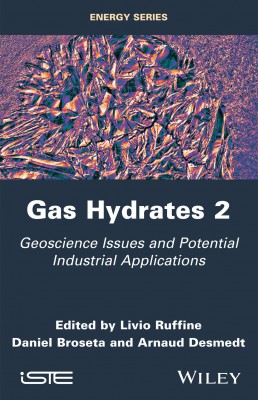
In recent years, interest for clathrate hydrates has increased, motivated both by their fascinating physiochemical and thermophysical properties and their industrial and practical promises in various areas of application.
Following the 2017 publication of Volume 1, which focused on fundamental aspects, modeling and characterization methods, this volume gathers a series of contributions addressing the natural occurrence of clathrate hydrates in sediments on Earth, with implications for the methane cycle, geohazards and energy resources, and then a few promising industrial applications.
This volume is intended for scientists, PhD students and engineers who wish to start working on clathrate hydrates and/or want to acquire general knowledge in this area. It presents, in a simple way, the approach commonly used to investigate marine gas hydrates and details numerical models to describe the geochemical and geomechanical dynamics of such systems. The volume ends with state of the art reviews on the promises and challenges of using clathrate hydrates in technologically important areas: cold storage and distribution, and geological storage in marine sediments of carbon dioxide and its capture from gaseous, methane-rich streams.
Part 1. Field Study and Laboratory Experiments of Hydrate-bearing Sediments
1. Water Column Acoustics: Remote Detection of Gas Seeps, Carla Scalabrin and Stéphanie Dupré.
2. Geophysical Approach, Bruno Marsset.
3. Hydrate Seismic Detection, Stephan Ker.
4. Geomorphology of Gas Hydrate-Bearing Pockmark, Vincent Riboulot.
5. Geotechnics, Sébastien Garziglia.
6. Geochemistry, Livio Ruffine, Sandrine Chéron, Emmanuel Ponzevera, Christophe Brandily, Patrice Woerther, Vivien Guyader, Audrey Boissier, Jean-Pierre Donval and Germain Bayon.
7. Benthic Ecosystem Study, Karine Olu, Laurent Toffin and Christophe Brandily.
8. Physicochemical Properties of Gas Hydrate-bearing Sediments, Ludovic Legoix, Elke Kossel, Christian Deusner, Livio Ruffine and Matthias Haeckel.
9. Small-scale Laboratory Studies of Key Geotechnical Properties which are Not Possible to Measure from In Situ Deployed Technologies, Sébastien Garziglia.
Part 2. Modeling of Gas Hydrate-bearing Sediments and Case Studies
10. Geomechanical Aspects, Assaf Klar and Shun Uchida.
11. Geochemical Aspects, Wei-Li Hong and Malgorzata Peszynska.
Part 3. Geoscience and Industrial Applications
12. Biogeochemical Dynamics of the Giant Pockmark Regab, Alexis De Prunelé, Karine Olu, Livio Ruffine, Hélène Ondréas, Jean-Claude Caprais, Germain Bayon, Anne-Sophie Alix, Julie Le Bruchec and Louis Géli.
13. Roles of Gas Hydrates for CO2 Geological Storage Purposes, André Burnol.
14. Hydrate-Based Removal of CO2 from CH4 + CO2 Gas Streams, Daniel Broseta, Christophe Dicharry and Jean-Philippe Torré.
15. Use of Hydrates for Cold Storage and Distribution in Refrigeration and Air-Conditioning Applications, Anthony Delahaye, Laurence Fournaison and Didier Dalmazzone.
Livio Ruffine is a research scientist at the French Research Institute for the Exploitation of the Sea (Ifremer) in Brest, France. His research interests focus on the oceanic methane cycle, with an emphasis on the geochemical dynamics of gas-hydrate deposits.
Daniel Broseta is Professor and member of the Laboratory of Complex Fluids and their Reservoirs at the University of Pau and Pays de l’Adour in France. His research interests are in interfacial and colloidal phenomena.
Arnaud Desmedt is a CNRS researcher at the Institute of Molecular Science at the University of Bordeaux in France. His main research interests are molecular spectroscopy (experimental and modelling) applied to inclusion chemistry and fundamental issues on clathrate hydrates.